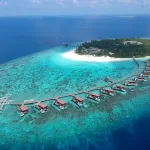The Maldives are probably best known for pristine beaches and idyllic wooden villas which extend out into the bright blue ocean. It certainly is a magical place to disconnect and relax, but what you might not know is that it is also one of the world’s top diving destinations.
Temperate, crystal clear waters and an extraordinarily diverse mixture of marine life have made The Maldives a must-visit destination for keen divers the world over. There are dives suitable for every ability level, and all the luxury resorts have diving centers. There are many independent ones too.
If you are a keen diver of any level planning a trip to The Maldives, this quick guide contains everything you need to know about diving in the country.
When to dive
The best time for deep sea diving in Maldives is the northeast monsoon season between December and May. Despite the name, The Maldives are actually mostly dry and sunny during this season, and it is when the weather and the seas are most calm. Visibility during this season can be up to 50m on the eastern side of the islands, and the average is a strong 20-30m. Visibility on the western side is usually 15-20m. The temperature of the water is a balmy 25-30 Celsius.
Additionally, the currents at this time of year cause lots of plankton to flow into the area, attracting a wide variety of marine life.
The diving environment
The depth of most diving sites falls within the range of 10m to 40m, which is suitable for divers who are just starting out. This is great for first-timers because it means that if they get their PADI certificate early on in their stay, they will have many different dives to choose from during the rest of their time there.
Some dive sites in The Maldives visit shipwrecks, but most others showcase interesting underwater formations. There are three main types of formations that diving schools take you to visit, and on marketing materials the local words for them are often used. Learning them will help you choose a dive site that you find interesting.
For example, underwater mountains that are 8m deep or more are known as “thila.” These tend to be very large and are covered in coral, making them a good place to see lots of little fish and sealife.
Smaller mountains closer to the surface of the water are called “giri.” Their smaller size means they have fewer currents swirling around them, so these tend to be better for beginners.
Then there are “kandus,” which are valleys between islands, reefs, or atolls. These are where larger sealife is to be found, but they also have the strongest currents.
Marine life
What makes diving one of the most popular Maldives attractions is its diverse array of sea creatures. Manta rays and whale sharks are two of the biggest draws, both literally and figuratively. The gentle giants can be seen at all times of year. There are also a few not-so-gentle giants among The Maldives‘ many shark species, which include whitetip sharks and hammerheads, although nobody has ever been attacked.
You can also see ancient sea turtles, barracudas, and myriad other species of colourful fish.
Types of diving
Many different types of dives are available in The Maldives. Because of the strong currents in the kandus between atolls, one of the most popular is drift diving. However, there are also opportunities for deep diving, wreck diving, night diving, shark diving, and more.
Conclusion
Divers of all abilities love diving in The Maldives because of its excellent clarity, spectacular submarine landscapes, and interesting sea creatures. With hundreds of islands and sites to choose from, you will never see them all in one trip. However, with this guide, you can know what’s available and find a diving tour to suit your interests.







